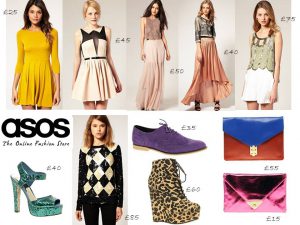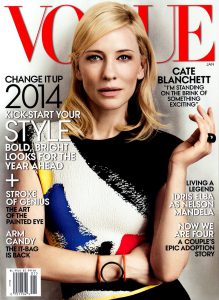Women’s magazines are as captivated by e-commerce as their readers and fashion advertisers. And that’s saying something. In the UK, online takes an estimated 40-50% of fashion shopping. The global market is dominated by the UK-based ASOS and Net a Porter, launched within days of each other in 2000, and now generating revenues of £800m and £500m respectively. ASOS is the world’s most visited fashion web site, with 30m unique monthly visitors and 8m active customers placing 2m orders annually across 200 countries. And it’s packed with free content. No wonder the world’s leading fashion publishers are envious.

E-commerce seems to be the magazine industry’s golden opportunity to “move up the value chain” and deliver real sales for their advertisers. Publishers have been quietly encouraged by the fact that Net a Porter was launched by former journalist Natalie Massenet and ASOS by one-time media buyer Nick Robertson: media people with content-rich, shoppable web sites – and even their own printed magazines.
Online fashion retailing is booming almost everywhere and is increasingly mobile. Young women – who may be losing the magazine-reading habit – love the convenience, choice, low prices and click-to-buy content of e-commerce.
ASOS (originally “As Seen on Screen”) has been profitable for a whole decade. Its revenues have increased by 30-50% for the past five years. In 2013, pre-tax profits jumped by 37% to £55m – with 7% margins almost twice those of the UK’s largest retailer, Tesco. And some two-thirds of sales are now from outside the UK.
Worn by celebs
Celebrities including Michelle Obama, Kate Middleton, Victoria Beckham, Katy Perry, Taylor Swift and Rihanna are snapped in low-cost ASOS fashions. The company has a stock market value of some £6bn. Although the upmarket Net a Porter has yet to make a profit, it is expected to be worth more than £2bn when it is (eventually) sold by luxury group Richemont. And this week’s IPO valuation of UK-based Boohoo is expected to be £560m – some 6 x revenue and 50 x profit. But, for all the cash and cachet of e-commerce and its apparent proximity to magazines, there are two good reasons why publishers should be cautious about it:
- The ASOS and Net a Porter websites certainly resemble those of the best media. But behind them are highly-impressive product-sourcing, marketing and distribution systems designed, essentially, to meet Amazon-style standards of customer service. ASOS’s profitability is sustained despite a return rate of some 30-50% on clothes that customers are effectively trying before buying. Most delivery is free. But, in the UK and many other markets, next day delivery is also free to customers who order more than £100 of goods – even if some or all are subsequently returned (free) and refunded. Many shoppers return the clothes even before payment has reached ASOS. If customers themselves give a wrong address, the company collects and re-delivers without delay or charge. Like Amazon, ASOS is setting high standards for customers – and high hurdles for competitors.
- Magazine readers treasure the objectivity and authority of editors. This independence would clearly be at risk if publishers become large-scale retailers. Magazines might just have to choose whether to stick with their existing business model – or go ‘native’ and compete on service not just content. Either way, e-commerce can wreck the traditional economics of magazines.
‘Amazon of fashion’
So, publishers might need to reinvent themselves even to stand a chance in e-commerce. But, then, their traditional model is threatened anyway, with signs that many more magazines will need to be free (or very low-priced) and be bundled as part of membership-like services; and ‘native’ advertising will need to be linked to sales and direct response. But ASOS should scare them.

The London-based company has long sought to become the Amazon of fashion retailing, the destination for 20-somethings who go online to spend at least 40% of their fashion budget (and, perhaps, 80% of their ‘fast fashion’). Nick Robertson wants ASOS to be as synonymous with fashion as Google is with search, and to be the default destination for choosey shoppers: “Young women have better things to do than go to the high street….A woman has ten to twenty brands in her closet. If she’s online, is she going to go to 10 or 20 websites?”
Unlike Amazon, which has tested pop-up shops, he has no plans to open physical stores. The ASOS presence in the physical world is a 450,000 circulation, good-enough-to-buy monthly magazine which has become a key part of its marketing: “The first pound of marketing an online business goes into delivery and returns, and we spend £100m a year on making that free. The second pound goes into how best to represent ASOS. So we use content: our emails, the fashion magazine, the mobile app. The convergence between retail and media, this is it. The business model for magazines, that was advertising revenues, is now clothes sales.”
A media business
- The ASOS iPhone and iPad apps, Facebook shop, mobile sites, and Fashion Finder tool are key to ensuring easy-access for shoppers. A live feed on its Fashion Finder shows off new outfits

ASOS: magazine-like content – but everything is for sale created by community users, and mood boards highlight the latest trends, styles and colours for inspiration. Every item is shoppable fashion fodder. Its social media channels are full of personal responses to tweets as well as competitions designed to engage users. ASOS projects itself as “a global online community of fashion lovers”, an approach that magazines will recognize more readily than traditional retailers. Meanwhile, international markets have ASOS twitter feeds and web sites for UK, USA, France, Germany, Spain, Italy, Russia and Australia, highlighting trends and insights into consumer demand. ASOS constantly experiments with offers for specific groups of users through addressable content.
- ASOS delivers to some 230 countries from its UK distribution centre, now with satellite centres also in the US and Australia. Its easy returns, no-quibble approach even to customer mistakes, and free delivery to most parts of the world are straight from the Amazon playbook. Now, it is planning an early warning delivery service to give customers night-before notice of what time their parcel will arrive via email or text message. They can then choose between five different options, including delivery to a safe place, collection from the nearest depot, delivery to a neighbour and a delivery upgrade to before 10am or on Saturday morning delivery. Customers can change their options from a smartphone, tablet or desktop computer at any time if they can’t be at home. That’s on top of a Follow My Parcel service, enabling customers to track their purchases, right down to their doorstep, and enabling them to see a 15-minute delivery slot. It’s an approach that recognises London-based Econsultancy research showing no less than 50% of all online shoppers would abandon a purchase if delivery options were inadequate.
The obvious question is: can media companies do e-commerce anywhere near as well as ASOS does media?

Conde Nast seems to be convinced. The Vogue publisher has established a London-based e-commerce division with the promise that a global effort will begin before the end of 2014. This has followed some magazine experiments, for example with Essence and Teen Vogue which, for the past year, have had shoppable web sites using 72Lux technology.
More important, though, are the US company’s $50m+ investments last year in: Paris-based luxury e-commerce site Vestiaire Collective; the UK-based FarFetch online marketplace for independent boutiques; and – in Germany – Monoqi, the online store for high-end furniture, and ReneSim online jewellery. These deals followed the 2012 investment in Rent The Runway. Conde Nast has been busy splashing its cash and learning the lessons of e-commerce. More than anything else, of course, the publisher is trying to work out how best to use its brands and content to create a point of difference – and a new source of profits.
That’s a more moneyed version of the searching going across New York at Hearst Magazines, where digital whiz Troy Young sounds slightly cautious: “I think e-commerce is really interesting. The media market has jumped on it as a way to find additional revenue streams. I think it’s important to recognize that the relationship with consumers comes first, because e-commerce requires trust… and I think media companies are trying to figure out where they fit. My mindset is that unless we are creating a tremendous amount of value, consumers will just find easier ways to buy. You have to have a relentless focus on what consumers really want.” You can bet he has also been all over the full-scale e-commerce operation that Hearst, intriguingly, inherited in Japan as part of its 2011 worldwide acquisition of Elle magazine.
Hearst learns fast
Hearst last year established its E-Commerce Council, which sounds just a shade bureaucratic, but it has been learning fast from relationships with Amazon, Net-a-Porter and HauteLook (owned by US retailer Nordstrom). Two Hearst e-commerce ventures, cladmen.com and giftinggrace.com with retailer J.C.Penny, failed along the way. Marie Claire et al notched up c$2m of revenue from the HauteLook deal. The Amazon deal runs right across Hearst’s US magazines: On Good Housekeeping‘s web site, editorial product reviews are tagged with click-to-purchase availability at Amazon. But it was the company’s prestigious 150-year-old Harper’s Bazaar click-through deal with Net-a-Porter that really turned Hearst heads. The upshot was the launch of ShopBazaar, an online marketplace with editorial content and editor-selected product that readers can click to buy.
The company’s flagship Cosmopolitan magazine is, however, the one to watch. Its 64 international editions make it the leading women’s magazine and it’s been a badge for independent-minded young women across the world for almost 50 years. But Cosmo circulations have been sliding nearly

everywhere as women increasingly spend their time and money on social networking and magazine-like e-commerce. So you can expect Hearst to be pulling out all the stops to secure the future of its most famous magazine brand.
Since June last year, all the content on Cosmo’s US iPad edition has been ‘shoppable’, courtesy of Shop Advisor technology which enables readers to buy items or to get price alerts if they want to purchase later. The magazine can generate revenues from: commission on products they help sell, additional yields from ads featuring the technology, and ‘personally-addressable’ offers to readers who have previously expressed an interest in a product. Like Hearst’s UK ‘white label’ deal with online retailer The Hut (under which readers can shop from the Elle and Harpers Bazaar sites), these ventures have interesting revenue and brand extension possibilities. But they seem unlikely to trouble ASOS, Net a Porter or major high street retailers.
The development of iPad editions has generally tended to encourage women’s magazine publishers to use click-through ways for readers to buy products they are reading about.
Some of these services are more distinctive than others. But results show that magazine “readers” are sometimes just that, with shopping activity carried out in a different frame of mind and at a different time.
Specialists making it work
But some publishers are successfully developing e-commerce in specialist sectors. US hobbies and craft publisher F+W Media has become a significant online retailer, according to CEO David Nussbaum who says:“Our e-commerce business will be over $50 million in 2014.” And Future Plc, of the UK, has similarly developed e-commerce across its craft portfolio. These niche publishers are able to meet the aspirations of their readers for a one-stop shop in sectors where market knowledge and practical content can keep them competitive.
Somewhere between niche and mass market, Rodale – the US-based, fast-growing publisher of Men’s Health, Runners World, and Prevention – last year launched a stand-alone e-commerce operation. It curates and sells “eco-luxury” goods in line with Rodale’s eco-friendly, health conscious publishing. But it carries almost no branding of the company’s magazines or books and has no direct product tie-ins from advertisers.

This is a more significant strategy than it might appear. After years of magazine-linked e-commerce – for example in running gear and race entries – Rodale has become a substantial online retailer.
The integration of all-media and retail can clearly be very effective. But in the mass market – with competition from the best online and physical retailers – the risks are substantial. Magazine publishers cannot assume that e-commerce is an easy way of plugging the revenue gap created by the loss of advertising and copy sales.
Conde Nast might just move from their minority e-commerce shareholdings to buy some of the companies and, in doing so, will acquire the necessary skills and resources. But they might also be learning (and perhaps this is what Hearst too is discovering, in Japan) that full-blown e-commerce is a different business – and not necessarily suited to publishers, despite the media trappings of ASOS, Net a Porter and others.
That might be difficult for publishers to accept, especially at a time when Net a Porter has just launched its Porter magazine – as a paid-for title on UK newsstands. The fact that media content may be more effectively “added” to retail operations than vice versa may be the best motivation for some imaginative collaborations. Might the next direct competitor for ASOS be a new-style joint venture between an e-commerce operator and a media group? Not for the first time in this digital century, a media sector may need to contemplate collaboration with the natives rather than competition. Get used to it.
1 Sept 2015 update: Asos chief executive and founder Nick Robertson is expected to step down from the online fashion giant in the “coming months”, according to reports. He has told the ASOS board that he wants to leave his post, but remain as a non-executive director, Sky News reported today. The company’s chief operating officer (and former Chief Financial Officer) Nick Beighton is reportedly in line to replace Robertson (Retail Week).
Today’s share price values the company at £2.5bn on the London Stock Exchange.
Have you read?
Can magazines really compete as online retailers? http://wp.me/p3I5kw-10I




